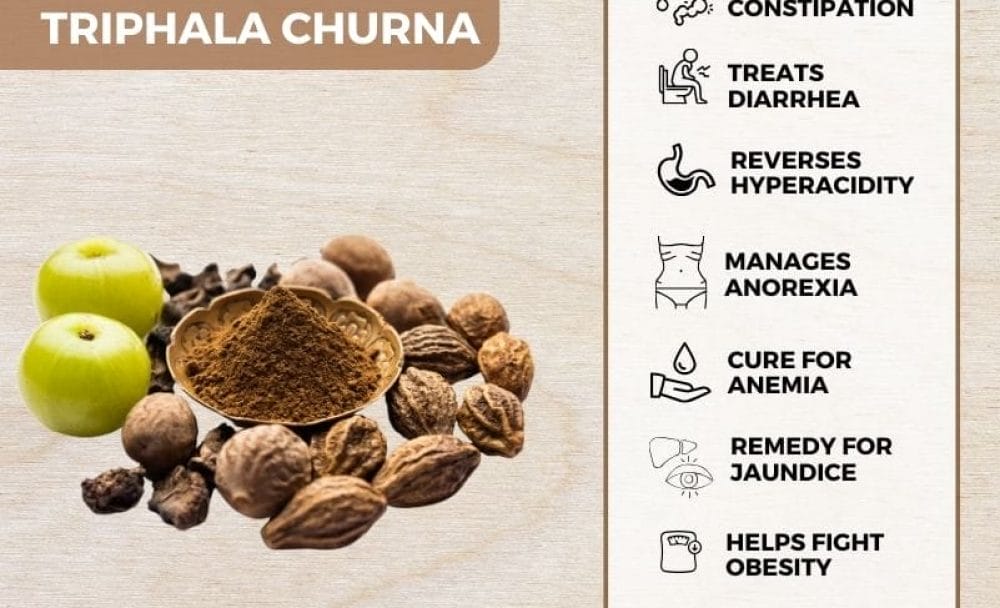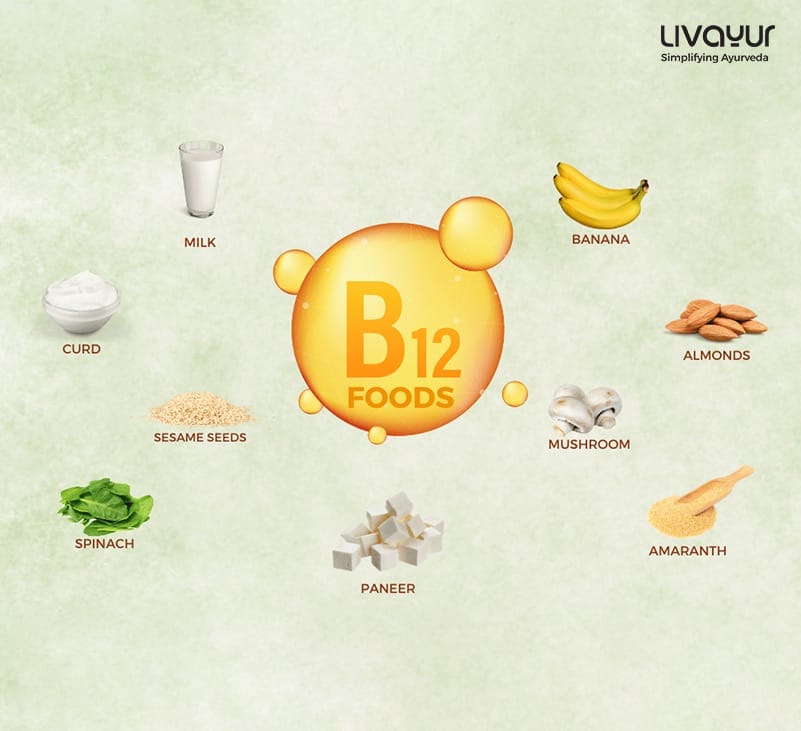
What is Triphala and why is it important?
Triphala, literally translates to “three fruits”. It is an equi-proportional blend of three fruits, namely, Amalaki (Emblica officinalis), Haritaki (Terminalia chebula), and Bibhitaki (Terminalia bellerica). 1
This blend is usually consumed in the form of Triphala churna. Triphala churna uses and benefits can be attributed to its rejuvenating properties. It is due to the presence of these properties that it is described in ancient Ayurvedic texts as a Tridoshic Rasayana. 2
The warm energy of Haritaki and Bibhitaki and the cooling nature of Amalaki help balance the three Doshas in Ayurveda – Vata, Pitta, and Kapha. 2
To understand more about the Triphala churna uses and Triphala churna benefits, let’s dive in.
Uses of Triphala churna
The Triphala churna uses are varied. Finding its main use in gastrointestinal treatment, Triphala churna is said to improve digestion and promote proper food absorption. Some more Triphala churna uses are reducing serum cholesterol levels, improving circulation, increasing the production of red blood cells and hemoglobin, and more.
The potential uses of Triphala are mainly due to its various properties such as: 3
- Antioxidant
- Anti-inflammatory
- Antipyretic
- Analgesic
- Antibacterial
- Antimutagenic
- Detoxifying
- Stress-reducing
Some other therapeutic Triphala uses are: 2
- Used as a laxative for chronic constipation, colon, cleansing, digestion problems, and poor food assimilation
- Used as a remedy for cardiovascular diseases, high blood pressure, and reduction of serum cholesterol
- It is also used for poor liver function, large intestine inflammation, and ulcerative colitis.
Due to its rejuvenating properties, Triphala is also considered a great tonic for hair.
Did you know?
According to Acharya Charaka, daily consumption of Triphala Rasayana has the potential to make individuals live for 100 years, without any aging or diseases. 3
Benefits of Triphala Churna
Before we dive into the Triphala churna benefits, it is important to understand its chemical constituents.
Triphala owes its antioxidant properties to tannins, gallic acid, ellagic acid, and chebulinic acid. 3 Further, Triphala also contains other bioactive compounds such as flavonoids (e.g., quercetin and luteolin), saponins, anthraquinones, amino acids, fatty acids, and various carbohydrates. 3
With the presence of the above-mentioned chemical constituents, Triphala benefits are:
1. Promotes gastrointestinal health
- Studies have shown that Triphala consumption reduces constipation, mucous, abdominal pain, hyperacidity, and flatulence. 3
- It also improved the frequency, yield, and consistency of stool. 3
- Various animal studies have shown that Triphala benefits also include diarrhea prevention and gastroprotective effects on stress-induced ulcers in the gut. 3
2. Reduces stress
- Triphala has the potential to mitigate stress and cold stress-induced biochemical and behavioral abnormalities. 3
- A significant increase in LO or lipid oxidation as well as corticosterone levels can be reduced by the administration of Triphala. 5
3. Promotes cardiovascular health
- The incidence and extent of cardiovascular disease make it the leading cause of mortality around the globe. 3
- Triphala has been traditionally used in several cardiovascular diseases, high blood pressure disease, and serum cholesterol reduction. 4
- Several studies suggest that Triphala helps in the reduction of total cholesterol, triglycerides, and total protein. 3
4. Is anti-diabetic
- In vitro studies suggest the administration of Triphala may reduce blood sugar levels. 5
- Previous research indicates that Triphala may exhibit effects akin to those of diabetic pharmaceutical drugs. It achieves this by inhibiting digestive enzymes, potentially leading to a reduction in the absorption of glucose through the inhibition of glycolytic enzymes. Consequently, this mechanism contributes to the lowering of blood glucose levels. 3
5. Delays aging
- Results of various studies have shown the potential of Triphala benefits against aging effects. 3
- Certain in vitro studies have demonstrated Triphala’s ability to increase collagen and elastin, increase cellular antioxidants, and decrease hyperpigmentation. 3
6. Heals wounds
- Triphala powder is said to arrest bleeding when applied on fresh cuts and wounds. This is attributed to its astringent and styptic properties. 2
- It is also common to use Triphala guggulu as a remedy for wounds. 6
7. Reduces obesity
- Research findings have highlighted the promising potential of Triphala as a therapeutic agent for weight loss and the reduction of body fat. 3
- Treatment with Triphala resulted in a decrease in the percentage of body fat, body weight, and energy intake. 3
- Additionally, Triphala exhibited a notable impact on reducing total cholesterol, triglycerides, and low-density lipoprotein cholesterol when compared to the control group in the experimental study. 3
How to use
Triphala churna is typically used by preparing the powders of its 3 fruits – Haritaki, Bibhitaki, and Amalaki – mixed in equal ratios. It is usually administered with ghee, honey, or milk. 7
However, there are other ways to consume Triphala. They are as follows: 7
1. Triphala Kwatha (decoction)
- Boil 1 part Triphala powder with 16 parts water
- Bring to boil until reduced to 1/8th of the initial quantity
- Strain the fluid with a clean cloth and use the filtrate for topical application
2. Triphala Taila (oil)
- Boil Triphala powder with oil at prescribed proportions
- Use orally or for topical application
3. Triphala Mashi (ash)
- Heat Triphala powder at a lower temperature for a long time
- Ensure the heating continues in a controlled environment
- Use the black ash of mashi for topical application
4. Triphala Gritha (ghee/clarified butter)
- Mix Triphala with Trikatu, black pepper, ginger, grapes, Yestamadhu, Kutki and cardamom
- Ensure the ratio of Triphala is threefolds that of the other ingredients
- Use the Triphala ghee or gritha orally or for topical application
Side Effects & Precautions
Triphala is generally considered safe if administered within the prescribed limit and frequency.
However, it is important to keep some pointers in mind before administering:
- Ensure you purchase Triphala churna from a reliable brand.
- Consult a medical professional before adding Triphala to your lifestyle as it may interact negatively with certain medications.
FAQs
1. What is Triphala?
2. How can I consume Triphala?
3. Can I consume Triphala churna daily?
4. What are the Triphala fruits?
5. Is Triphala good for hair?
Conclusion
Triphala churna has proven to be a versatile and beneficial herbal remedy with a range of applications. From promoting gastrointestinal health and reducing stress to cardiovascular benefits and potential anti-diabetic effects, Triphala offers a holistic approach to well-being. Its antioxidant-rich composition contributes to its numerous advantages, including reducing obesity, delaying aging effects, and promoting wound healing. The diverse ways of consuming Triphala, such as through decoctions, oils, ash, and ghee, provide flexibility in incorporating its benefits into one’s lifestyle. However, it is essential to use Triphala with caution, adhering to recommended dosages and consulting a healthcare professional, especially for individuals on medication.
Disclaimer
This article is written from a health and wellness perspective and is not medical advice. Kindly seek the help of a certified medical practitioner before initiating any treatment or dietary modification.
References
- https://www.sciencedirect.com/science/article/pii/S2215017X17302278?via%3Dihub
- https://www.researchgate.net/publication/269846920_Triphala_A_comprehensive_ayurvedic_review
- https://www.ncbi.nlm.nih.gov/pmc/articles/PMC5567597/
- https://www.bioline.org.br/pdf?pt06008
- https://www.phytojournal.com/archives/2016/vol5issue3/PartA/5-2-33-672.pdf
- https://www.ijhsr.org/IJHSR_Vol.11_Issue.7_July2021/IJHSR043.pdf
- https://sci-hub.st/10.1007/s11655-012-1299-x




















